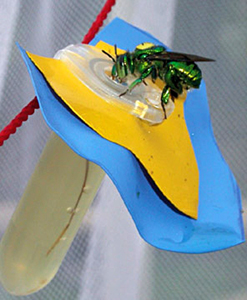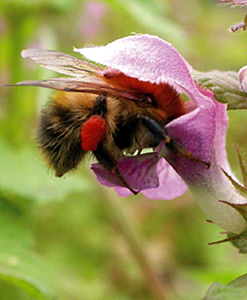Chemical and Sensory Ecology of Bees
|
||||
We study how odours influence foraging and reproductive behaviour of bees (Hymenoptera, Apidae), and how olfaction evolves in response to behavioral and ecological requirements. The perception of volatile chemicals is phylogenetically old and occurs in all terrestrial lifeforms. In the life of extant bees, odours present themselves in two rather distinct forms: Plant-derived odours, e.g. that of food resources (flowers) or nest construction material (resin, trichome secretions), and bee-derived odours, e.g. specific pheromones used for communication among bees. Chemically, the two classes of odours are also quite distinct: Plant odours are often terpenoids, whereas many bee pheromones are fatty-acid derived lipids. Our group studies a range of olfaction-driven phenomena: Male orchid bees perfume themselves with environmental odours for courtship, bumblebees perceive and avoid their lipoid footprints while foraging on flowers, and wool-carder bees use various plant substrates in nest construction. We use behavioural experiments, chemical analysis (GC/MS), electrophysiological screens (EAG, GC-EAD), and molecular techniques (microsats, DNA sequencing) to shed light on these behaviours and to gain an understanding of the selective pressures driving the evolution of bee olfaction. |
|
RUB » Dekanat für Biologie und Biotechnologie » Evolutionsökologie und Biodiversität der Tiere - Mitarbeiterhomepage PD Dr. Th. Eltz



